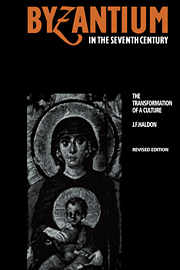Book contents
- Frontmatter
- Contents
- List of plates
- List of maps
- Preface and acknowledgements
- Preface to the revised edition
- List of abbreviations
- The sources
- Introduction
- 1 The background: state and society before Heraclius
- 2 The East Roman world c. 610–717: the politics of survival
- 3 Social relations and the economy: the cities and the land
- 4 Social relations and the economy: rural society
- 5 The state and its apparatus: fiscal administration
- 6 The state and its apparatus: military administration
- 7 Society, state and law
- 8 The imperial church and the politics of authority
- 9 Religion and belief
- 10 Forms of social and cultural organisation: infrastructures and hierarchies
- 11 Forms of representation: language, literature and the icon
- Conclusion: The transformation of a culture
- Addendum: Further observations on the question of the late ancient city
- Bibliography
- Index
3 - Social relations and the economy: the cities and the land
Published online by Cambridge University Press: 13 November 2009
- Frontmatter
- Contents
- List of plates
- List of maps
- Preface and acknowledgements
- Preface to the revised edition
- List of abbreviations
- The sources
- Introduction
- 1 The background: state and society before Heraclius
- 2 The East Roman world c. 610–717: the politics of survival
- 3 Social relations and the economy: the cities and the land
- 4 Social relations and the economy: rural society
- 5 The state and its apparatus: fiscal administration
- 6 The state and its apparatus: military administration
- 7 Society, state and law
- 8 The imperial church and the politics of authority
- 9 Religion and belief
- 10 Forms of social and cultural organisation: infrastructures and hierarchies
- 11 Forms of representation: language, literature and the icon
- Conclusion: The transformation of a culture
- Addendum: Further observations on the question of the late ancient city
- Bibliography
- Index
Summary
The study of the relations between dependent and independent peasant communities on the one hand, and their landlords – ecclesiastical or secular, private or state – on the other, has long been the source of much thought-provoking debate among historians of the early Byzantine period. The discussion and the variety of often contradictory answers given by different historians to the questions which the period poses illustrates the main problems: there are simply not enough written sources for the period to enable a clear and detailed picture of social relationships in the provinces (for example) to emerge. We cannot expect the sort of information available for the sixth century, therefore, and the sorts of results it is possible to extract from such material are not forthcoming for the seventh century. But the problems are not insoluble. It is possible to build up the basic outlines of the developments of the seventh century from archaeological, epigraphic, sigillographic and numismatic sources, among others, which can complement the available literary documentation. By employing these materials within a coherent framework or set of models, it is possible to obtain a shadowy picture of seventh-century social and economic relations, within which the available evidence can play a role without contradictions and upon which an understanding of developments in the subsequent period can be reached.
The essential elements in any analysis of seventh-century society are represented by the relationships between the state and the sources of its revenue, and by that between the rural population and their means of production – land, livestock and tools – and those who owned or controlled those means of production.
- Type
- Chapter
- Information
- Byzantium in the Seventh CenturyThe Transformation of a Culture, pp. 92 - 124Publisher: Cambridge University PressPrint publication year: 1990
- 1
- Cited by



